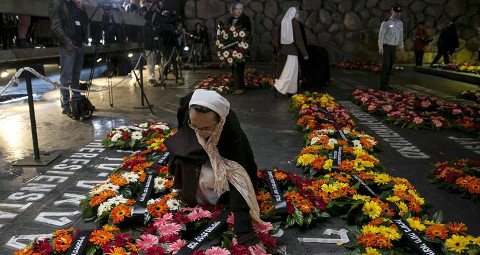December 7 | ![]() 0 COMMENTS
0 COMMENTS ![]() print
print

The Yad Vashem Holocaust memorial holds a lesson for us all
Peter Kearney says we must face up to the evils of religious persecution
In her moving poem On the Pulse of Morning, Maya Angelou wrote insightfully about history and humanity’s tendency to forget, when she said: “History, despite its wrenching pain, cannot be unlived, and if faced with courage, need not be lived again.”
Her words were a powerful call to face up to and learn about our past in order to understand it and avoid repeating the mistakes and the misdeeds of earlier generations. Sadly, it is not a message which carries much resonance in Scotland. Collective amnesia and widespread ignorance of our past seem to be the norm. Nowhere more so than in relation to our tumultuous religious history, where a wilful unwillingness to acknowledge our past holds sway.
Anyone visiting the official websites of Historic Scotland or Visit Scotland will find euphemism and revisionism dominate descriptions of our country’s myriad ruined abbeys, cathedrals and monasteries. They are all remarkably coy in their descriptions of what today are usually desolate ruins.
A perfect example being the Visit Scotland website which describes the now ruined Cambuskenneth Abbey outside Stirling as ‘one of Scotland’s most important abbeys,’ though incongruously says it is now ‘home’ to ‘a fine collection of medieval grave slabs and architectural fragments.’
We’re told euphemistically, that ‘the abbey fell into disuse during the Scottish Reformation’ and ‘became a quarry for stone reused in various parts of Stirling.’ It adds: “In 1559, the abbey is said to have been ‘ruined and cast down’ by Reformers.”
How strange that we don’t learn why it isn’t there anymore. The reason is simple. The Scottish reformation, led by John Knox, led to a riotous orgy of iconoclastic destruction across Scotland which saw ancient statues, paintings, stained glass, altar cloths, vestments and buildings smashed to pieces and torn to shreds.
In a pattern of looting, desecration and destruction repeated across Scotland, the religious and cultural patrimony of our nation was demolished. To this day our national heritage and tourist bodies refuse to acknowledge the violent destruction visited upon our country, ensuring that generation after generation can never learn from it. The past is concealed behind a pact of silence.
Jewish community
This is in stark contrast to the approach taken by the Jewish community remembering the Holocaust. During a recent visit to Israel, I was privileged to be given a tour of Yad Vashem, the World Holocaust Remembrance Centre.
It was an experience moving beyond words and a reminder of the depths of inhumanity humans are capable of.
Maya Angelou’s words claim that ‘if faced with courage’ our past, however horrific, ‘need not be lived again.’ Yad Vashem faces the past with unblinking honesty and a determination that the world must never forget.
The name Yad Vashem (a monument and a name) comes from Isaiah 56:5: “I will give them an everlasting name which shall not perish.”
Had the malignant masterplan of Adolf Hitler succeeded, the Jewish people would indeed have perished. They came perilously close to extinction and their survival and the steely determination of those who left the ruins of Europe was strong enough to build a nation and create a lasting monument to unimaginable suffering.
Yad Vashem is set on the Mount of Remembrance in Jerusalem. As well as the Holocaust museum its campus contains a vast archival collection of information and documents which record one of the darkest chapters in the history of humanity. The challenge for the institution is to keep the Holocaust relevant today and for future generations. It achieves this goal with distinction by presenting the unvarnished truths of history, clearly and unambiguously.
The Nazis ‘Final Solution’ saw the murder of six million Jews in four and a half years. It is impossible to look at artefacts and images from this era—posters, identity cards, armbands, newspapers—and not be struck by the banality of evil. Like the well organised society it was, Germany simply turned to the eradication of Jews from Europe as it might have addressed any other task: with ruthless efficiency and chilling order.
Culture of death
Leaving Yad Vashem, I stepped out from its cavernous exhibition rooms into the warm sun of a beautiful Jerusalem afternoon, the excited babble and chatter of busloads of school pupils a vivid reminder of the exuberance of young life and a welcome antidote to the museum’s painstaking cataloguing of the culture of death.
With their smartphones, the young people were no different from teens across the world—filled with hope and promise. Unlike their peers however, these youngsters are different: they are the children of Israel. Their ancestors were, in the words of Isaiah (48:10), tested ‘in the furnace of affliction.’ Together with every school child in Israel they will visit this monument, they will learn of the past and their knowledge will help them make sense of the present.
—Peter Kearney is director of the Scottish Catholic Media Office










